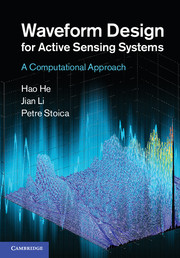1 - Introduction
Published online by Cambridge University Press: 05 August 2012
Summary
The goal of an active sensing system, such as radar or sonar, is to determine useful properties of the targets or of the propagation medium by transmitting certain waveforms toward an area of interest and analyzing the received signals. For example, a land-based surveillance radar sends electromagnetic waves in the direction of the sky, where objects such as airplanes can reflect a (usually very tiny) fraction of the transmitted signal back to the radar. By measuring the round-trip time delay, the distance (called the range) between the radar and the target can be estimated since the speed of propagation for radio waves is known (3 × 108 m/s). Additional target properties can be obtained by performing further processing at the receiver side; e.g., the speed of a target can be estimated by measuring the Doppler frequency shift of the received signal.
In 1904, a German engineer named Christian Hülsmeyer carried out the first radar experiment using his “telemobiloscope” to detect ships in dense fog by means of radio waves. As to sonar, Reginald Fessenden, a Canadian engineer, demonstrated this in 1914 using a sound echo device, though not successfully, for iceberg detection off the east coast of Canada. It was amongst several other experiments and patents said to be prompted by the 1912 Titanic disaster.
Radar and sonar underwent considerable development during the two world wars and later on spread into diverse fields including weather monitoring, flight control and underwater sensing.
- Type
- Chapter
- Information
- Waveform Design for Active Sensing SystemsA Computational Approach, pp. 1 - 14Publisher: Cambridge University PressPrint publication year: 2012
- 1
- Cited by



